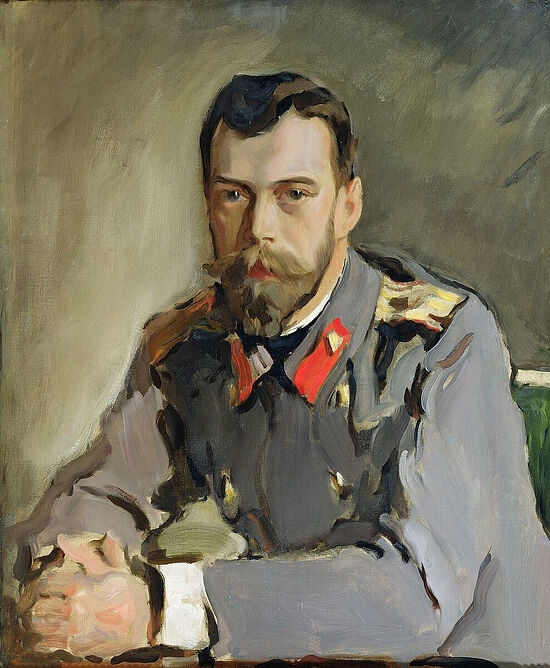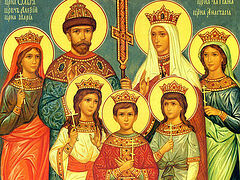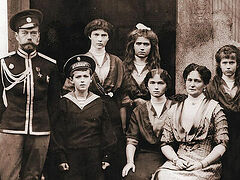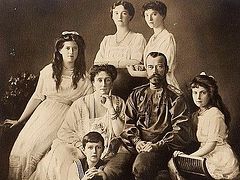On July 17, the Russian Church honors the memory of the Royal Passion-Bearers—Emperor Nicholas II, Empress Alexandra, and their children. Archpriest Stephan Pavlenko, rector of the Church of All Saints Who Shone Forth in the Land of Russia in Burlingame, California, in an interview with the portal Pravoslavie.ru, recalled the process of glorification in the Russian Orthodox Church Outside Russia (ROCOR). He also shared how his father saw the Tsar up close in his youth, and years later, told us of an amazing dream.
His father was struck by the Sovereign’s gaze
 Valentin Serov. Portrait of Emperor Nicholas II. 1900
Valentin Serov. Portrait of Emperor Nicholas II. 1900
My father, Vladimir Stepanovich Pavlenko, came from a clergy background. Both my grandfather and great-grandfather, as well as all my known paternal ancestors, were priests. My father also intended to follow this path, but when he was studying at the seminary World War I broke out, and he enrolled in a military academy. By the time he graduated the revolution had already taken place in Russia, and he became a soldier in General Wrangel’s army.
Once, when my father was still studying at the seminary—he was around sixteen or seventeen years old—Emperor Nicholas II visited their region in southern Russia. This was during the celebrations of the 300th anniversary of the House of Romanov.
Naturally seminarians, just like any students from other institutions, prepared eagerly for the Tsar’s visit. My father saw him up close and was deeply impressed. He carried the memory of that event throughout his life. He recalled that what stood out the most about the Tsar were his eyes, his eyes, and again his eyes—a very penetrating gaze that touched the soul.
I probably had somewhat similar feelings on the day of Patriarch Kirill’s enthronement. Many criticized him at the time, and I allowed myself to do so as well. When he served his first Liturgy in the Kremlin as the Primate of the Russian Church, I was in Moscow but could not serve with him, so I was in the church with the faithful.
After the service, I dared to enter the altar to personally congratulate the Patriarch. I thought if I got stopped along the way, so be it. But no one stopped me. His Holiness was just going to unvest and was still standing in his vestments. I had important and sweet words spinning in my head that I would say. I approached for a blessing, and the Patriarch blessed me, making a wide sign of the cross. For the first time in my life, I felt such a gracious power from this blessing—I felt it physically, spiritually, with my entire being.
I believe the Tsar’s gaze touched my father’s soul in the same way that the Patriarch’s first blessing touched mine.
Father looked at the calendar and saw that it was July 17
My parents were always very devoted to their lost homeland. They had great respect and reverence for the Tsar. Because of this, our family always knew how important the Royal Martyrs were. They were part of our understanding of who we were and what it meant to be a Russian Orthodox person.
Once, my father recounted a dream in which Emperor Nicholas II appeared to him and said, “You have forgotten me.” Upon waking, my father looked at the calendar and realized it was the day of the Tsar’s family’s murder. Usually, we never missed the memorial services that were held on July 17 in the churches of the Russian Diaspora.
I do not know of any other miraculous occurrences related to Nicholas II involving our family or friends. However, I do know that, at one time, an icon of Nicholas II was painted for the family of my former parishioners, a copy of which later began to exude myrrh in Moscow. Iya Dmitrievna Schmidt, who worked at our church school and considered the Tsar-Martyr her patron, asked another of our former parishioners, Pavel Nikolaevich Tikhomirov, to paint this icon. She then made several lithographs from it, and her brother, Abbot Herman (Podmoshensky), took them to Russia. One of these lithographs started to exude myrrh, and this happened even before the Moscow Patriarchate canonized the Royal Passion-Bearers. In my opinion, this is a miracle.
Bishop Nektary said: The New Martyrs, led by the Tsar, will pray for the liberation of Russia.
It must be said that the process of glorification in the Russian Orthodox Church Outside Russia (ROCOR) took quite a long time. This was due to the fact that even in emigration, there were people who believed that Nicholas II had failed to take responsibility and that this led to the downfall of Russia. I also knew those who could not understand why the Tsar needed to be glorified. But in the end, those who held such positions agreed that the Tsar and his family were passion-bearers who humbly accepted their fate.
This issue was discussed at the Bishops’ Councils as far back as the 1970s. Bishop Anthony (Senkevich) gave reports on the significance and importance of the glorification of the Tsar’s family. Of course, even then, groups of people—if not to say parties—formed, one delaying process, the other encouraging it.
I don’t remember the specific year, but Bishop Nektary (Kontsevich) once said in a sermon that when the New Martyrs, led by the Tsar, were glorified, they would kneel before the Lord in Heaven and ask Him to free Russia from the godless Soviet power. And so it happened.
I am convinced that the glorification and veneration of the Tsar and his family, the understanding of the truth about them, are important not only for the faithful of the Russian Church and for Russia but also for all Orthodox Christians and ultimately for the whole world. The Tsar was not just the leader of a vast empire—he was an Orthodox man who cared for his people like a father. The truth about him was distorted by the Bolsheviks and the liberal world. But when it was revealed, it became clear that the Emperor was an outstanding statesman.
Both the Tsar and his family, like all saints, show people the path they should follow. If you read the last letters and diaries of the Empress and the children, you will see in them an example that all Orthodox Christians should follow. They showed us that you can be poor, or be the richest and most influential person in the world, but at the same time, you can be a saint. In my opinion, this is very, very important.




